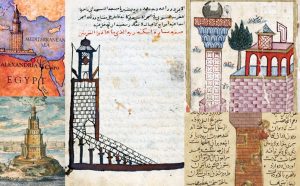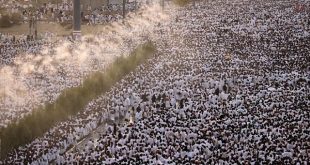The Lighthouse of Alexandria is one of the wonders of the Ancient World. It was still a great tourist attraction well into the medieval period, and was visited by many travellers to the city that were impressed by its magnitude.
The Lighthouse of Alexandria is one of the classic “Seven Wonders of the Ancient World” [1], [2], [3]. It was still a great tourist attraction well into the medieval period, and was visited by many travellers to the city that were impressed by its magnitude.
1. Who, Where and When
The lighthouse was constructed in the 3rd century BC.[4], [5], [6]“During the reigns of Ptolemy I [Soter 367-283 BCE] and his son Ptolemy II Philadelphus [285 -246 BCE (Ptolemaic)], Alexandria developed into a great city”.[7] The height, form and multifunction of the lighthouse never failed to impress its visitors as it was located on the small Island of Faros, off the city coast.
The lighthouse was particularly admired and often visited and described by people from Islamic civilisation. This could be due to partly of mighty size, but perhaps also because of the interest in its technology as seen in the function of its mirrors. “Whereas pre-Islamic literary descriptions of the light house are scarce, Muslim authors provide, along with various legends, valuable accounts of its configuration throughout the medieval period.”[8]
A number of 12th century Andalusian travellers left remarkable accounts of the lighthouse such as Ibn Jubair, Abu Hamid Al-Gharnati and Yousif Ibn al-Shaikh Al-Balawi shortly before “destroyed by series of earthquakes between 956 and 1323”[9], [10]. According to “Alexandria: City of the Western Mind” by Theodore Vrettos “Pharos Lighthouse most likely met its fate in the earthquake of A.D. 1365. The magnificent blocks of granite and marble toppled into the harbor and interfered with shipping for almost a hundred years before a channel was cleared of the biggest pieces. As late as A.D. 1480, the stump of the tower still jutted from the Heptastadion. Shortly after that, the sultan of Egypt, Kait Bey [Qaitbay] built a fortress and castle there, using the marble base of the fallen Pharos for walls.”[11]
| A size comparison of the Ancient Lighthouse of Alexandria (PHAROS) between a 1909 study (Thiersch) and a 2006 study of the building (Shenouda) (Source) |
2. Height and Description
There are very different opinions on the height of the lighthouse (eg. See the figure on the right). Because of different views, its size varies dramatically, to an extent the number roughly changes between 100 and 200 meters high. Size calculations were mostly based on the witness records of travellers from Muslim World.
For example according to 10th century travellers al-Idrisi and Yusuf Ibn al-Shaikh[12] “the building was 300 cubits high. Because the cubit measurement varied from place to place, however, this could mean that the Pharos [Lighthouse of Alexandria] stood anywhere from 450 (140m) to 600 (183m) feet in height…”[13]
Another example “The Arab descriptions of the lighthouse are remarkably consistent, although it was repaired several times especially after earthquake damage. The height they give varies only fifteen per cent from c 103 to 118 m [338 to 387 ft], on a base c. 30 by 30 m [98 by 98 ft] square… the Arab authors indicate a tower with three tapering tiers, which they describe as square, octagonal and circular, with a substantial ramp”.[14]
Overall it seems enormous in the eyes of the travellers of those times. As Ibn Jubayr witnessed it “competes with the skies in height…”[15]
3. Arabic Sources
There are other interpretations of its description from the Islamic World such as:
- Al-Mas’udi (9-10 Century) mentions the founder of the Tulunid dynasty Ahmed Ibn Tulun’s additions to the light-house (9th Century).[16]
- Full description of the lighthouse by a Arabic writer Abou Haggag Youssef Ibn Mohammed el-Balawi el-Andaloussi in 12th Century.[17], [18]
- Muhammad ibn Iyas (15th Century) mentions an earthquake damaging the light house. around the reign of caliph Harun al-Rash’d time (9th Century).[19]
- There are also al-Bakri and Nasir-i Khusraw in 11th Century; Muqaddasi in late 10th Century and many more…
It has been said that it was seriously impaired by number of natural disasters, eventually collapsed completely and last of it remains castoff in the construction of the Citadel of Qaitbay dated back to late 15th Century[20],[21]. It lasted for a long time as one of the ancient wonders, alongside with the Mausoleum at Halicarnassus and the present Great Pyramid of Giza.
 Komashisha
Komashisha




